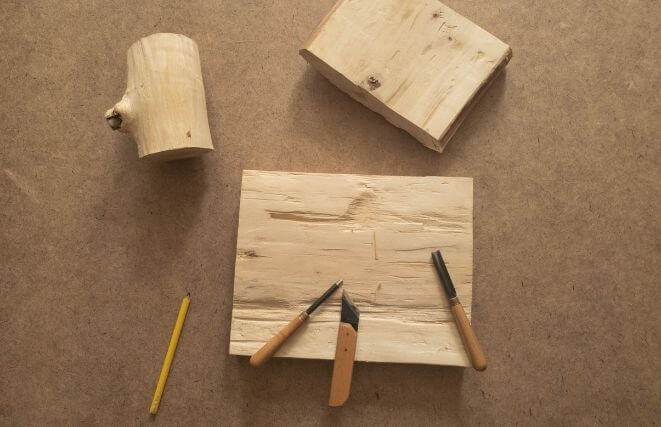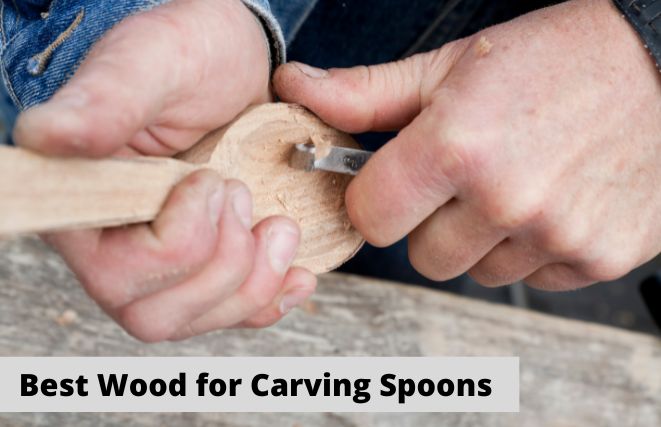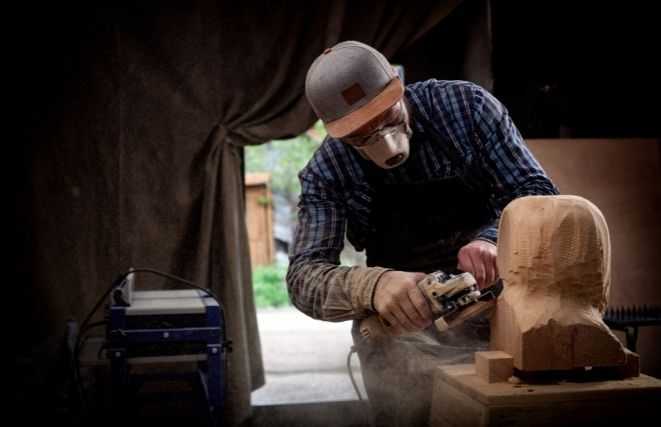Theoretically, carving just about all types of wood is possible. However, the tools you choose to use often define the kind of project and the woods that are advisable. In wood carving, hand tools tend to be favored among woodcarvers. For newcomers to the discipline, you may want to stay away from hardwood species at the onset of your woodworking journey.
Softwood may be a better choice for whittling and hand carving at first, after which you may begin to delve into the tougher species. Interestingly enough, while hardwood species may present a more difficult challenge than their softer counterparts, they often possess unique properties that result in some of the most beautiful projects possible. Generally, you want woods with neat grains for your projects.
It is not just about the carving tools and the wood type though as your capability and objective are also parts of the equation. What kind of wood carvings have you done in the past? Do you have exposure to many different types of wood? Was each type easy to carve? How many grain patterns are you familiar with? Did you use power tools or hand tools? If you did use power tools, can you handle the switch to hand tools? Do you place yourself along the lines of beginners, intermediate woodworkers, or experts?
The next consideration is whatever has you carving wood in the first place. What are you looking to create? Is it a piece of art or are you intending on creating intricate furniture? Do you know the type of wood that aligns best with your goal? It can seem like a bit much to take in, but if you want to do your best when you have wood to carve, you must think about all the variables that can make or break the experience. You don’t just want things to turn out fine. They must be incredible!

Top 9 Types of Wood for Carving
For one thing, you should leave here knowing the best wood for carving! Even if it is not an objective surety, you need to know what works for you. The entries below should highlight various properties of each type of wood listed, as well as other information that should be incredibly beneficial to your potential projects. Whether you have functional, decorative, or other material requirements, get ready to see the light! So, without further ado, it is time to dive into the wood types!
Basswood (Lime Wood)
You can identify basswood by its very white color. There is a hint of light brown, but it is not sharp enough to pop out to the eyes. The growth rings that are synonymous with this wood are very subtle.
If your designated wood for carving is basswood, you’ve made an excellent choice. Carving basswood happens to require less expertise than other woods on this list. That’s what makes this softwood species so popular among beginners. Your whittling skill is likely green to non-existent as a new carver, so when the wood gives you an advantage, that is a huge plus for you to celebrate.
Lime wood is even a popular choice among more seasoned carvers. It has a fine grain, which means you don’t need to worry about it getting chipped or splitting as some other woods may. Carving basswood is a breeze because of its soft texture. You can all but exercise your will over the wood with your carving knife as you work towards completing whatever project you may be working on.
If you can get basswood directly from a tree that would be perfect. The closer your carving wood is to the source, the better. However, if that option isn’t available, feel free to drop by a hobby store to get your hands on the softwood. If you do happen to have access to basswood from trees, however, you get two benefits in one.
First, you have a supply of basswood near you for carving whatever items you deem suitable. Second, and more importantly, the easy to carve wood is great for cutting your teeth in the carving world. It is undoubtedly one of the best sources of woodworking practice as you can easily make cool items, such as forks and spoons. Bowls are also a possibility that you may wish to consider.
Those who have carved basswood before also know, that it is one of the only types of wood that is suitable for carving in both its green and its dry state. You would either need to put it down for a while or buy it if you want the dried version. Naturally, getting it directly from the tree gives the soft, green texture.
It is almost natural that lime wood would be hailed as the best wood by many whittlers. This even goes for those who are into relief carving. The combination of the soft texture, grain pattern, and responsiveness to carvers makes it hard to top.
Check the latest price on Amazon
Black Walnut
Black walnut is not the kind of popular choice basswood is, and you could attribute that to its natural difficulty curve. If you wanted to sell someone on the best wood for carving based on skill level requirements alone, then you may want to choose something else. This wood does also have an odor but it is not at all overpowering.
Nevertheless, those who stick with it for their wood carving needs tend to be favorably rewarded if they can push on straight to the project’s finish line. It features one of the most beautiful grain patterns known to wood carving, which makes it very easy to understand why it is North America’s priciest hardwood.
You can make some of the most enchanting furniture with black walnut, and it is almost unreal sometimes. Interestingly enough, it may have one of several different appearances depending on where it is grown. You can find black walnut in caramel-brown, coffee, purple, and several things in between. As you would expect, they are all beautiful.
Though the skill requirement is high, there is a lot of wiggle room to create beauty from problems. For example, you may end up finding a block that boasts a straight grain. If so, you can carve beautiful pieces. However, black walnut can also appear as a small, knotted block. Is that an issue? Nope! You can just lean into the waves and curves of the hardwood.
Even with all that in mind, it is generally a good idea to leave black walnut alone unless you can afford it and have the hand carving experience to tackle it. If you lack any of these things, you’re best off with another type of wood or the power tools to whip to get this one carved into shape.
Check the latest price on Amazon
Butternut (White Walnut)
Similar to basswood, butternut is most suitable for beginners. You do not need to rely on power tools as it responds well to hand carving too. White walnut is a nickname that butternut got because its grain resembles that of black walnut. It should not take you very long to understand why a type of wood that bears a resemblance to one of the most sought-after carving wood types would be a mainstay in the whittling and woodworking disciplines.
Woodcarvers love the fact that it is a much easier wood type to carve than its darker counterpart. Its texture also contributes to the kind of woodworking applications that you are likely to see it in. While it is not impossible to use butternut for furniture, it tends to be a popular choice for artistic carvings.
For example, you may have seen some well-carved pieces in places, such as museums and churches that seem to have a natural allure to them. These decorative elements may have been made from butternut. As you would expect, the wood carving is mostly done by hand based on the highly responsive nature of the softwood. Note that this kind of wood does have an odor but it is incredibly tolerable.
Of course, you could take the route other carvers did and use butternut as a more cost-effective option to mimic black walnut. Even so, butternut is more than a piece of wood in another variety’s shadow. It is quite beautiful with its light brown hue, and it can give a nice bit of color to whatever you may carve.
Feel free to use the soft texture of butternut to your advantage to create kitchen items, little statues, or even heirlooms. As the carver, what you do with the material is your choice, but the idea is to help you realize that the possibilities with a wood type such as butternut are virtually endless.
Utensils, such as spoons, that are made from this variety of wood tend to last for a long time, and more complex pieces stick around too!
Check the latest price on Amazon
Mahogany
Mahogany tends to have a straight or interlocked grain. This type of carving wood is not as hard to deal with as black walnut is, but it is also not as easy to carve as butternut or basswood. It sits somewhere in the middle, which means that while you can use power tools to carve your pieces, you do not need to.
The typically reddish-brown wood type is a great choice for carving with your hand tools. You can think of mahogany as the midpoint where the difficulty to reward ratio is concerned. There is no doubt that furniture made from the material is bound to look great, but it is not the most brilliant and outstanding wood for carving on this list.
Since mahogany sits in the middle of the difficulty spectrum, it may not be the most suitable carving wood for beginners. However, with a set of sharp hand carving tools, it should not feel impossible. Note that the aesthetic of mahogany is not always reddish-brown. There is a range of colors that progressively include less brown until you are looking at a deep red piece of wood for carving.
You typically find mahogany in decorative and furniture-based applications for good reason. Apart from the properties indicated above, a carver may be drawn to its stability, favorable drying style, resistance to shock loads, and low stiffness.
Check the latest price on Amazon
Black Cherry Wood
Black cherry wood is another hop to the more advanced side of the wood carving spectrum. It has a straight grain and is beloved by those who have carved it. Even if you have never carved cherry before, seeing it may cause you to wish you did. This type of wood has a negligible odor, which is always a plus to work with.
Beginners had best stay away from this one though it is such a popular carver choice for furniture pieces. Its appeal mostly lies in its unique look. Black cherry wood is not far off from mahogany’s reddish-brown in many cases. However, it tends to be more along the lines of reddish-pink, red, or something in between.
When you are choosing a variety of wood to carve, you typically want to go for something that gives a nice look to your design. Furniture made from black cherry wood tends to pop out at you for good reason. The grain adds to the color in this regard. Grains may have been mentioned throughout various entries but not many of them have the same effect that black cherry wood’s grain does.
It is more visible than many other grain types, which adds a visual flair to your wood carving. You could contrast this to basswood that has a finer grain. When you go with such types of wood, the grain has little to no bearing on the final product.
Of course, all this grain talk doesn’t mean you should prioritize it. The visibility of grains is not something that benefits every product. Some wood carving projects require a uniformed and smooth finish, which you get from a fine grain.
It is time to refocus on the black cherry wood to avoid going too much further into all that. You are going to need some experience and strength to get this carving wood to align with your vision. It is as far from butternut and as close to black walnut as possible where hardness is concerned. It is a hardwood species through and through, which means you may need to pull on your trusty power tools.
Check the latest price on Amazon
White Oak
This oak speaks to a series of wood species that you may encounter. It is related to red oak, which is also used in the wood carving discipline. However, red oak is highly susceptible to moisture and decay. Therefore, it is not conducive to being the base for the kind of projects that white oak is.
For example, while red oak may not be the best wood in the world for furniture projects, white oak is an amazing type of wood for such a purpose. The only thing is it does not sit among the most beginner-friendly wood carving choices. This oak is a hardwood variety, so like others discussed before, it’s not the best option for people who lack the strength and experience necessary to work with such woods.
Here is yet another wood for carving that features one of the visible grains that is suitable for projects that get a bit of oomph from a heightened level of visibility. White oak happens to have a straight and coarse grain. So, when carvers saw it on the quarter, they get wood carving possibilities that feature a rippled style.
Identifying white oak and the wood that comes from it are not difficult tasks. You need only look out for the light, ash-gray-colored bark, which is next to unmistakable for any other kind of wood for carving. While its texture may not be the most suited for carvers (unless they can adequately work with such a type of wood), basket makers swear by the natural aesthetic and composition as one of the better woods for their kind of projects.
Check the latest price on Amazon
White Pine
Not many different types of wood for carving lie in the middle of the difficulty scale, but white pine fits the bill quite well. Interestingly enough, it is one of those woods that comes from a very common plantation forest tree. Such a tree is typically specifically grown in droves like crops are. The growing process is done for profit from the carving wood that it produces.
It may not be as easily carved as basswood, but it falls under the softwood category. So, what makes this carving wood variation so difficult to work with? Well, its green state is one of the biggest problems in this regard. White pine (and pine in general) happens to be one of those woods that is incredibly resinous. That means there is a lot of sap to deal with during the carving process.
Sticky varieties of wood are not the most beneficial to the carving discipline, which means they are not too popular among carvers. If you have never tried wood carving in a sticky situation, then you are likely unfamiliar with how tough it is. White pine also leaves your skin covered in a black residue after you have carved it in this state.
Your wood carving knife also takes a beating from the process. Additionally, white pine is known for having quite a few knots in its composition. It allows for beautiful wood carvings if the carver is skilled enough, but a beginner is likely to have a harder time.
Of course, you can circumvent the difficulty by exclusively choosing to carve the softwood in its dried state. So, you could opt to purchase pre-dried blocks to work with, which happens to be a popular choice among woodcarvers. You do need to keep an eye out for knots as you carve your pieces though, so be careful.
Check the latest price on Amazon
Aspen Wood
Aspen wood is another delightful choice for carvings as it is incredibly soft. It is even slightly softer than basswood, so you can imagine that many pieces are carved using it as a base. The grain is straight and fine in this wood, but it does not take detail very well. Woodcarvers can be as sharp or precise as they wish when they create their pieces because aspen wood accommodates detail very well. You could use it to create simple spoons. Bowls that complement them can also be on the wood carving agenda. On the flip side, detailed heirlooms and other decorative pieces can be carved with aspen wood.
Note that as you carve this soft variety, things may get fuzzy. Aspen wood is one of those types that is known for that property. Experienced woodcarvers may know how best to avoid this and a part of the secret is keeping the carving knife blade sharp.
This is also one of those woods that is easy enough to get your hands on. If you need a soft base for wood carving that can give you the benefits of basswood while being more readily available, aspen wood is probably your best bet.
Check the latest price on Amazon
Maple Wood
Maple wood ranges from softer to hardwood varieties. While it can be one of the visually appealing woods available, it is not the most popular choice for carving since it can be very challenging for those hoping to create something from it. First, the grain is not as straight as it is in some other varieties of wood.
The second issue with maple wood is that it can often blotch in its finished state. The issue with that is such a problem shows up in the form of a density variance.
Again, if you have experience in the wood carving discipline, you can get around these issues. Doing so gives you unmitigated access to a wood type that holds detail incredibly well and can have a high shine finish that is very visually pleasing.
Maple wood is also famous for its numerous grain names, including curly, fiddleback, birdseye, etc., that can all create some magnificent effects in your pieces. Still, it is a variety of wood that is best left to the experienced carvers, even if they are only making spoons.
Check the latest price on Amazon
Green Wood Vs. Dry Wood Carving Options
Different woods have different properties based on what varieties they are. Basswood is very soft, black walnut is a hardwood, mahogany falls in the middle, etc. However, the freshness of the cut has bearing on carvings too. A beginner may not know this, but an experienced carver knows that dry wood is not always better.
Green wood tends to be softer and easily cut, and it can grant you greater carving accuracy. Dry wood offers greater stability, is easier to find in stores, and there’s no sap to deal with. On the final point, sappy green wood is almost an instant problem unless you have much experience.
Frequently Asked Questions
What wood is good for carving for beginners?
Wood carving is a hobby that has been enjoyed by many for centuries. There are many different types of wood that can be used for carving, but what is the best type of wood to start with?
The best type of wood to start with for beginners would be Basswood. Basswood is soft and easy to carve, making it a perfect choice for beginners. It is also inexpensive and abundant in nature.
What is the softest wood for carving?
The softest type of wood to carve is pine, which is also one of the most commonly used woods for carving. The next softest type would be basswood or cedar. These woods are still quite hard, but not as hard as oak or maple.
What is the best wood for carving and whittling?
Wood carving and whittling is a form of art that offers a sense of accomplishment and satisfaction. It is a hobby that anyone can undertake and it doesn’t require any special skills or tools.
The best wood for carving and whittling is hardwood, because it’s easy to carve, doesn’t splinter too much when you’re cutting, and it’s easier to sand the edges smooth. Softwoods are not recommended for carving because they tend to be more brittle than hardwoods.
What is the hardest wood to carve?
The hardest wood to carve would be oak. Oak is not as soft as other woods, so it can withstand more force. It also has a higher density than some other woods, and it does not warp easily when cut with tools.
Is pine OK for carving?
There are many different types of wood that can be used for carving. Pine is one type. It is best to use pine if you are looking for a soft wood that will not splinter easily when carved.
Conclusion: The Best Wood for Carving
There is no single wood type that can definitively take the top spot. Depending on your view, you may side with many other woodcarvers in saying that basswood or black walnut takes the top spot. However, as indicated at the beginning, the natural properties of the wood do not account for the whole equation.
Your skill level and your intentions also matter. For example, wood such as mahogany may not be held in as high regard as black walnut, but it is incredible for furniture. Similarly, butternut is an easy enough wood to carve and it is suitable for heirloom design.
Think about factors such as availability as well and the aesthetic you want. All that should do the trick.















